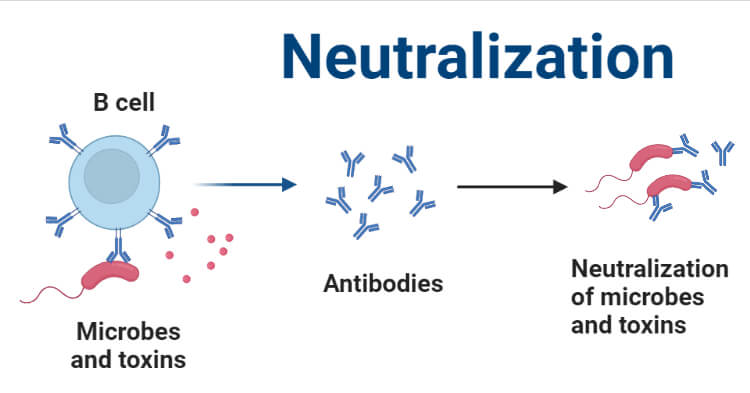Neutralization: Neutralization is a chemical process between an acid and a base that produces salt and water. When an acid reacts with a base, it produces salt and water. Neutralization reactions occur often in our daily lives.
Neutralization reaction
When an acid and a base combine to generate salt, water, and heat, this is referred to as a neutralization reaction.
The acidic and basic properties of the acid and base are lost in this process.
The combination of hydrochloric acid and sodium hydroxide is a typical neutralization reaction that results in the formation of sodium chloride.
HCl+NaOH→NaCl(salt)+H2O.
Examples of neutralization reaction
Several instances include the following:
a. Indigestion: This occurs when too much acid is produced in the stomach, resulting in indigestion. It is neutralized by eating an antacid such as milk of magnesia, which provides relief.
b. Ant Sting: When an ant bites, formic acid is injected into the skin. After that, the sting is mitigated by applying wet baking soda (chemical name sodium hydrogen carbonate) or calamine (which includes zinc carbonate) over the afflicted region.
c. Soil Treatment: When soil turns excessively acidic, it is neutralized using quicklime (also known as calcium oxide) or slaked lime (also known as calcium hydroxide).
You have studied the properties of acidic, basic, and neutral substances. However, how can you determine if a chemical is acidic or basic?
One option is to taste the material; however, this is not a safe practice. Certain compounds are utilized to identify whether certain substances are acids, bases, or salt, and they are referred to as indicators.
Natural Indicators in Our Environment
It is not advisable to taste each material to determine its acidity or basicity. Certain chemicals exhibit distinct hues in acidic and basic environments; these substances are referred to as indicators.
Definition of Indicators
Indicators are compounds that are used to determine the acidity, basicity, or neutrality of a material. When introduced to a solution comprising an acidic or basic chemical, they change color.
When introduced to a solution that contains an acidic or basic chemical, the indicator's color changes quickly.
There are two sorts of indicators: natural and artificial.
Litmus, Turmeric, China rose, and red cabbage are all indicators that occur naturally.
Litmus, China rose petals (gudhal), turmeric, and red cabbage juice are all examples of naturally occurring indicators.
In acidic and basic media, these indicators exhibit a range of hues. They are used to determine the acidity or basicity of a material
.Natural Dye - Litmus
Litmus is an indicator, found naturally, that is extracted from some lichens (small plants) and utilized in a dilute solution. Litmus is mauve (purple) in color when dissolved in water. It becomes red when immersed in an acidic solution. When put to a simple solution, it changes color to blue. Typically, it comes in two colors: red and blue litmus paper.
It becomes red when introduced to an acidic solution and blue when put to a basic solution.
It is offered as a solution or as litmus paper strips.
A) A red litmus test becomes blue, signifying the presence of a basic solution.
(B) In an acidic solution, blue litmus becomes red.
Another Natural Indicator is Turmeric
Turmeric is a brilliant yellow powder that is extracted from the turmeric plant. In Hindi, it is referred to as 'Haldi'. Turmeric includes a dye that is yellow in color. Turmeric appears red when dissolved in a basic solution. Turmeric paper is used as an indication.
China's Rose as an Indicator
A natural indication, China rose, is a water-based extract made from the red blossoms of China rose plant.
Additional forms of indicators are often utilized in everyday life and laboratories.
Phenolphthalein
Phenolphthalein appears colorless and is called as an acid-base indicator that turns pink to red when the solution gets alkaline.
It is a synthetic indication that is employed in the experiment of neutralization.
Olfactory substance as an indicator
Olfactory indicators are compounds that alter their scent when combined with an acidic or basic solution.
Clove oil, onion, and vanilla extract are all markers of this kind.
Visual Indicators
Visual Indicators are compounds that are used to visually identify (through a change in color) the state of a solution in the existence of a certain ingredient (as a free acid or base).
Examples include litmus, red cabbage, and phenolphthalein.
Basic Substances Identification
Magnesia milk, soap, and limewater all color red litmus paper blue. This demonstrates the fundamental character of these solutions.
Turmeric becomes red when soap, milk of magnesia, and limewater are added.
China rose turns green when soap, milk of magnesia, and limewater are added.
Acidic Substances Identification
When immersed in lemon juice and vinegar, red litmus paper stays red. However, they can change a blue litmus paper to red color. This demonstrates the solutions' acidic character.
Turmeric and China rose become yellow when lemon juice and vinegar are added.
FAQs:
Q1. We are familiar with the taste of acidic and basic substances. Is it possible for us to sample all of these?
Soln.: No, this is because acids and certain strong bases are harmful. To determine whether a solution is acid, base, or neutral, we utilize a pH scale.
Q2. How do you distinguish between acid, basic, and neutral elements?
Soln.: Acids are compounds that possess a high concentration of H+ ions. These are very caustic substances.
Basic chemicals or bases are those that possess a greater concentration of OH ions. These are non-corrosive substances.
Neutral substances: These are the solutions that do not affect the look of the red or blue litmus paper during the test. These chemicals are neither acidic nor basic.
Check out our videos here to learn more about Phenolphthalein.


